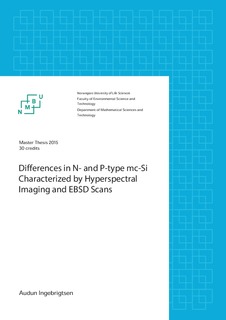Differences in N- and P-type mc-Si characterized by hyperspectral imaging and EBSD scans
Master thesis
Permanent lenke
http://hdl.handle.net/11250/293712Utgivelsesdato
2015-07-28Metadata
Vis full innførselSamlinger
- Master's theses (RealTek) [1722]
Sammendrag
Characterization of solar cell materials is an important step towards changes in the production processes which will lead to higher energy conversion efficiencies. Firstly, the methods used in this study allows mapping of the crystallographic orientation on the samples surface. Secondly, it allows a correlation between the crystallographic mapping to defect related luminescence (DRL) caused by radiative Shockley-Read-Hall (SRH) recombination. Thirdly, it allowed a comparison on DRL between N- and P-type mc-Si wafers.
This experiment contained 5 unpassivated (125 x 125) mm^2 mc-Si wafers, from three different ingots, produced in a pilot-scale furnace. In two of these (N- and P-type) Fe contamination was achieved by adding about 50 ppmw to the silicon feedstock. The wafer from the last ingot were a P-type reference. In the hyperspectral analysis the wafers were cooled down to 90 K, then irradiated with a 808 nm laser and the excited photons are detected with a SWIR (900-2500 nm) hyperspectral camera. The detected photons are caused by band-to-band photoluminescence (BB-PL) and DRL. In the Electron Backscatter diffraction (EBSD) scans, the wafers were cut, ground, polished and then put inside a scanning electron microscope (SEM). There a thin electron beam irradiate the sample which causes high energetic backscattered electrons (BSE) to emit and hit a fluorescent screen where electron backscattering patterns (EBSPs) are recorded by the detector. Multivariate Curve Resolution (MCR) was used for statistical analysis, to split up recorded the emission spectra into different defect related spectra.
In the study of the hyperspectral images the key findings are: The apparent absence of both D3 and D4 at the bottom of the ingot in the N-type Fe contaminated wafer. A weak D4-band for a N-type wafer high up in ingot. For both N-type wafers (from the bottom and high up in the ingot), there were an apparent absence or very weak signal for D3, but instead presence of strong VID3.
This study is the first attempt to examine how EBSD scans could correlate with images produced from hyperspectral imaging. Different forms and contours present in both the EBSD scan and the corresponding hyperspectral image were found. A broad signal with peak around 0.7 eV in the reference P-type wafer seems to correlate with where different crystallographic orientations meet. For a Fe contaminated P-type wafer one crystallographic direction appeared to match the PL-image for D2.
